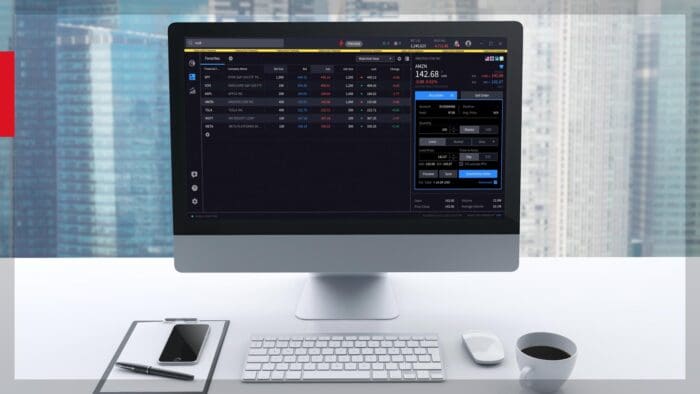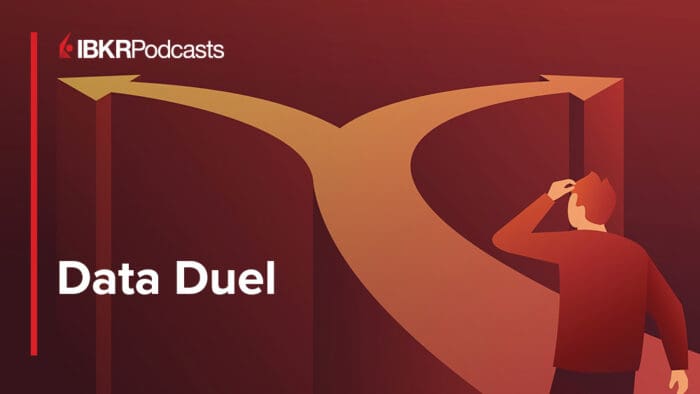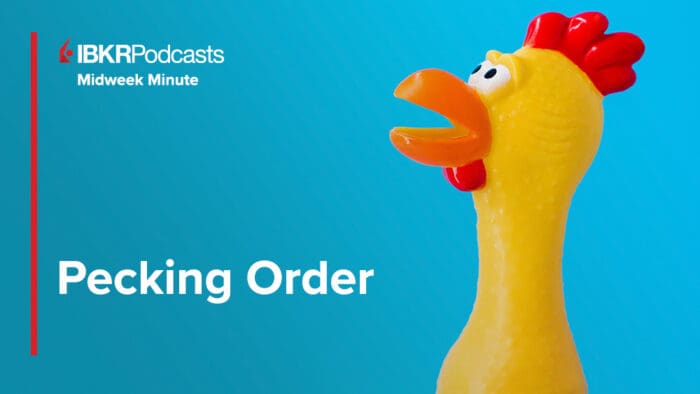Equity analysts and economists are at odds — MBAs are calling for earnings acceleration, while PhDs warn of an economic slowdown. In this episode, Nasdaq’s Michael Normyle joins us to unpack the data, the drama, and what it all means for investors navigating tariffs, rate cuts, and market uncertainty.
Summary – IBKR Podcasts Ep. 279
The following is a summary of a live audio recording and may contain errors in spelling or grammar. Although IBKR has edited for clarity no material changes have been made.
Jeff Praissman
Hi everyone, this is Jeff Praissman with Interactive Brokers. It’s my pleasure to welcome to the IBKR Podcast Studio Michael Al, the Senior Director of Economic Research at Nasdaq. Hey Michael, how are you?
Michael Normyle
Doing well, thanks. Glad to be back.
Jeff Praissman
It’s always great to have you on our podcast. There seems to be some conflicting opinions between MBAs and PhDs. The majority of equity analysts—generally MBAs—are forecasting earnings will accelerate in the upcoming quarters. And the majority of economists—generally PhDs—are forecasting that growth will slow down in the coming quarters, as tariffs weigh on earnings, CapEx spending, and consumer spending.
I love a good debate, and these seem to be very conflicting ideals. So let’s dive right into it. Given that higher tariffs typically lead to reduced consumer spending and decreased corporate investment, how do the equity analysts justify their optimistic earnings acceleration forecasts despite these economic headwinds, while the forecasters are viewing these as pessimistic?
Michael Normyle
I think maybe it’s worth laying out how economic theory says tariffs impact consumer spending and business investment. So tariffs are a tax paid by importers, and they naturally try to pass on as much of that cost as possible to consumers, and that results in higher prices, which then reduces demand.
For business investment, right now it’s being impacted in a couple of ways. First, there’s just policy uncertainty around where trade policy will ultimately land, so companies are holding off on investment until they have more clarity. Second, to the extent that they can’t pass on all of the costs of tariffs, that leaves them with less money for investment.
Now, analysts that have relatively modest earnings growth expectations for Q2 2025—looking for around 5% year-over-year earnings growth for the S&P 500—can partly justify that by the economy’s resilience to date. Plus, people front-loading spending before tariffs fully kicked in added to demand, and the fact that surveys show that most companies have been able to pass on the bulk of tariff costs, so they protected their margins a lot in Q2.
However, analysts aren’t fully turning a blind eye to tariffs. If you look at earnings by sector, we see a near-perfect split where services-heavy sectors are expected to see positive earnings growth, while goods-heavy sectors are expected to see negative earnings growth, given that they have more exposure to tariffs. And Deutsche Bank estimated that overall earnings would have been two percentage points higher without the tariff changes we’ve seen.
But going into the second half of this year and into 2026, analysts do expect even faster earnings growth. It’s likely due to a couple of factors. First, they expect trade deals to keep tariffs below their theoretical peak. Second, fiscal expansion of the One Big Beautiful Bill Act will boost demand. Plus, the Fed rate cuts are expected to begin again later this year and into next year, which should support demand and reduce interest expenses, helping that earnings growth.
Jeff Praissman
And you just divided between the service and the goods sectors as far as the earnings, but what about companies in general? So you mentioned the large-cap S&P 500. What are the analysts’ expectations for the mid and small caps?
Michael Normyle
The large caps are definitely expected to fare better, and that makes sense. Since they’re the largest, most profitable companies in the world, their net margins are around 13% compared to 8% for mid caps and 6% for small caps. So they tend to have better pricing power, making it relatively easier to pass on tariffs.
So analysts are actually predicting negative earnings growth for the S&P 400 mid caps and the S&P 600 small caps. And interestingly, if you look at the large cap strength—not just services versus goods—but if you look at MAG7 and AI, that’s still a driving factor, where the MAG7 earnings are expected to grow about 14% in Q2, compared to 3% for the rest of the S&P 500.
Jeff Praissman
And how are the corporations planning to maintain this growth even despite their expected slowdown with the capital expenditure while they’re waiting things out, especially considering these higher tariffs, which typically increase production costs?
Michael Normyle
Yeah, so the slowdown in CapEx lately—that’s, I mentioned it earlier—but it’s more a result of that policy uncertainty than anything else. So once policy becomes clearer, that should enable businesses to boost investment.
For now though, in the short run, reduced CapEx is actually reduced expenses in a sense. So that could help margins in the short term and help earnings growth—again, in the short term.
The problem would be if this investment is put off indefinitely and the lack of productivity-enhancing investment reduces their competitiveness. But that seems unlikely. It’s more likely that investment is merely just delayed a bit here.
But you’re right, the tariffs will add to cost. So companies will need probably a multifaceted approach to maintaining earnings. It’ll be passing on cost as much as possible, but also looking for efficiencies in production—like automation. Reassessing supply chains—that could mean locations and inputs. So you might source from a country that has a lower tariff rate or switch to a cheaper, possibly lower-quality input too, to save some money.
Jeff Praissman
And you briefly touched on this answering the first question, but maybe we could dive a little bit deeper regarding monetary policy and how it might play in supporting earnings growth during this period.
Michael Normyle
Yeah, I mean it’s hard to say what, I guess, degree of monetary policy or assumptions are going into this debate for the earnings estimates. But I think it’s likely that markets are probably pricing in more or less what markets are looking for, which is that the Fed’s going to resume their rate cuts in the second half of this year and going into next year.
So markets see the Fed funds rate around 3.5% in a year, down from 4.5% right now. I’m using the upper end of those—the ranges that the Fed uses. So that is a pretty significant decline, which should not only save on short-term interest expense but would also help support the economy—so hopefully boosting some demand there too.
Jeff Praissman
And you talked about AI and the MAG7 and obviously services versus goods. But again, getting a little bit more specific into this, what kind of specific sectors might be more resilient to tariff impacts while still showing these earnings growth potentials?
Michael Normyle
Yeah, I think at a high level, since tariffs are a tax on imported goods, it’s going to be the goods sector impacted most and the service sector impacted least—which, as I mentioned, we’re seeing in Q2 earnings estimates.
But getting into sectors specifically, it’s things like communication services—home to your Netflix, Google, Meta. Those are less directly impacted, as are financials, real estate, utilities, healthcare, and information technology.
Then within the goods sector, the most domestically focused companies will be better off. For example, an energy company that extracts oil domestically is less impacted than a clothing company that imports a finished good from a foreign country.
So it could be a challenging environment for things like consumer discretionary, since tariffs will make any kind of imported good more expensive. And so people might focus their spending more on consumer staples, leaving less money available for those more discretionary purchases. So that’s a few different, I think, ways that could impact along sector lines.
Jeff Praissman
Yeah, and we talked earlier about how large caps are gonna probably fare a little bit better than the mid or small caps, but in this day and age, every company’s basically global at this point—whether they’re taking goods in or exporting—and especially the larger cap ones too.
These companies we’re putting tariffs on—they’re most likely gonna take retaliatory measures from our trade. And how will this influence both the economic growth and corporate earning trajectories for these companies?
Michael Normyle
Yeah, I think retaliation would really be a major issue if it’s from one of our biggest trading partners—Canada, China, Mexico, the EU, et cetera—and if it results in a spiral of tit-for-tat retaliation. And we did see a bit of that earlier on this year with the US and China back in April and May, where the tariff rate on China got up to 145%. That would’ve been a big problem for a lot of US companies that rely on Chinese manufacturing.
If that had stayed the tariff rate… of course, that was short-lived with the US and China making a temporary truce in mid-May that goes into mid-August here. But if we see a replay of that without the truce, then that’s where corporates are gonna run into issues—where Chinese products become too expensive to use, and supply of alternatives is limited.
In either scenario though, that really means much higher prices. So that would be even weaker demand and a pinch on earnings. And we’ve been pretty lucky so far, where we haven’t seen a lot of retaliation. Most countries want to maintain a good working relationship as they try to hammer out trade deals. So we haven’t seen a lot of serious retaliation talk so far.
Jeff Praissman
And we have these two sides—we have the economists and the analysts really butting heads almost with where they think everything’s going. What are some indicators or metrics that investors can watch to determine which side is more accurate?
A lot of us are still on the sidelines—we’re looking toward the experts for opinions and forecasts. Two expert sides are going at a different angle. What can investors look at as far as following along and making their own opinion and using information for their investment decisions?
Michael Normyle
Yeah, for the economy, I think of course inflation is going to be important to watch. And we’ve actually only very recently started to see hints of tariffs impacting inflation in the June data that we got in mid-July. And basically the way that came through was that inflation rose more for goods with a higher import intensity—meaning we rely on imports for a greater share of demand.
So things like appliances, toys, sports equipment saw about 2% month-on-month price increases, whereas core goods overall saw 0.2% increases in June. So we’re starting to see that, but we want to watch and see if that’s gonna continue.
And it’s actually not that surprising that tariffs are just starting to show up in the inflation data, since there was a rush to import as much as possible ahead of tariffs. So back in January, February, and March, we saw the biggest goods trade deficits on record. In each of those months, the US imported about $150 billion more in goods than we exported. And that’s why we saw that negative GDP print in Q1.
On top of that, we’ve seen a number of tariffs that have been suspended for a while, so that’s blunted the impact of tariffs. So, a couple reasons why the impact on inflation’s been mild so far—but it’s something to watch, because that could make it hard for the Fed to justify cutting rates as markets are hoping for if that inflation ends up being stronger than a lot of people are expecting.
And we have seen some Fed officials worrying that the inflationary effects of tariffs will be more persistent, because they could result in less efficient supply chains, which results in higher prices and reduced investment—resulting in weaker productivity. So that’s a way where it could be more of a persistent problem than a lot of people suspect.
Now in terms of markets, I think one thing to watch will be the commentary from executives and the guidance in their Q2 earnings calls. We might learn how manageable or unmanageable tariffs have been. And of course, I think there is a scenario where both things end up being true—the economy slows, but earnings, especially for large caps, grow and they manage to keep doing what they’re doing. As the most profitable companies in the world, they’re able to pass on those tariff costs.
There is… and on top of that, there’s a case where multinationals benefit from a weaker dollar, since the money they make overseas is then converted to dollars at a better rate. So there can be a few mitigating factors here, and we might have an outcome where both end up being right.
Jeff Praissman
Yeah, ’cause I was gonna—my next question’s really piggybacking on this one—just for the next few quarters, what kind of needs to happen for either the economic forecast to be accurate or the equity analyst forecast to be correct or incorrect? And what are the implications on the investor in either scenario?
Michael Normyle
Yeah, I think that if the economic forecast for that tariff-induced drag is wrong, it probably is gonna require a series of significant trade deals where we lock in tariff rates closer to that baseline 10% that we’ve seen since Liberation Day.
That would really limit the increase in inflation and the hit to spending. And it’d give companies that policy clarity that they’re looking for—that could help them unlock investment opportunities. And so all of that, I think, would make the earnings outlook pretty feasible and would likely be well received, based on how markets reacted to postponement of the Liberation Day tariffs, for example.
But for analysts to be wrong, it probably would require a significant slowing in the economy or escalation of the trade war—or both—which would result in much weaker demand, higher input costs, and that’s gonna be tough to keep growing earnings in that scenario.
Jeff Praissman
Michael, as always, this has been great to have you on the podcast studio. For our listeners, for more from Michael Normyle and Nasdaq, go to our ibkr.com, click on “Education”—you can see materials in our podcast, our articles, and our webinars.
Also go to nasdaq.com as well to see more information from their great economists there. Michael, thanks again. Looking forward to next month.
Michael Normyle
Great, thanks.
Join The Conversation
For specific platform feedback and suggestions, please submit it directly to our team using these instructions.
If you have an account-specific question or concern, please reach out to Client Services.
We encourage you to look through our FAQs before posting. Your question may already be covered!
Leave a Reply
Disclosure: Interactive Brokers
The analysis in this material is provided for information only and is not and should not be construed as an offer to sell or the solicitation of an offer to buy any security. To the extent that this material discusses general market activity, industry or sector trends or other broad-based economic or political conditions, it should not be construed as research or investment advice. To the extent that it includes references to specific securities, commodities, currencies, or other instruments, those references do not constitute a recommendation by IBKR to buy, sell or hold such investments. This material does not and is not intended to take into account the particular financial conditions, investment objectives or requirements of individual customers. Before acting on this material, you should consider whether it is suitable for your particular circumstances and, as necessary, seek professional advice.
The views and opinions expressed herein are those of the author and do not necessarily reflect the views of Interactive Brokers, its affiliates, or its employees.
Disclosure: Nasdaq
Index
Nasdaq® is a registered trademark of Nasdaq, Inc. The information contained above is provided for informational and educational purposes only, and nothing contained herein should be construed as investment advice, either on behalf of a particular security or an overall investment strategy. Neither Nasdaq, Inc. nor any of its affiliates makes any recommendation to buy or sell any security or any representation about the financial condition of any company. Statements regarding Nasdaq-listed companies or Nasdaq proprietary indexes are not guarantees of future performance. Actual results may differ materially from those expressed or implied. Past performance is not indicative of future results. Investors should undertake their own due diligence and carefully evaluate companies before investing. ADVICE FROM A SECURITIES PROFESSIONAL IS STRONGLY ADVISED.
© 2023. Nasdaq, Inc. All Rights Reserved.
Options
For the sake of simplicity, the examples included do not take into consideration commissions and other transaction fees, tax considerations, or margin requirements, which are factors that may significantly affect the economic consequences of a given strategy. An investor should review transaction costs, margin requirements and tax considerations with a broker and tax advisor before entering into any options strategy.
Options involve risk and are not suitable for everyone. Prior to buying or selling an option, a person must receive a copy of Characteristics and Risks of Standardized Options. Copies may be obtained from your broker, one of the exchanges or The Options Clearing Corporation, One North Wacker Drive, Suite 500, Chicago, IL 60606 or call 1-888-OPTIONS or visit www.888options.com.
Any strategies discussed, including examples using actual securities and price data, are strictly for illustrative and education purposes and are not to be construed as an endorsement, recommendation or solicitation to buy or sell securities.
© 2023. Nasdaq, Inc. All Rights Reserved.
















Weird how all of this has happened since I got back about 500m in stock commodities and crypto that was stolen from me back